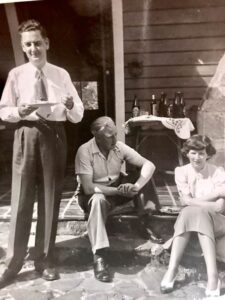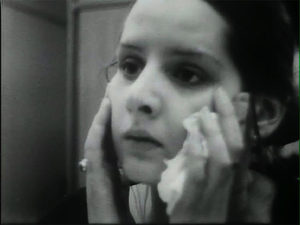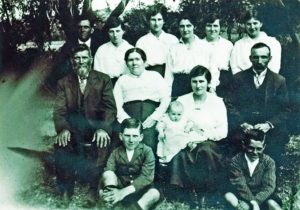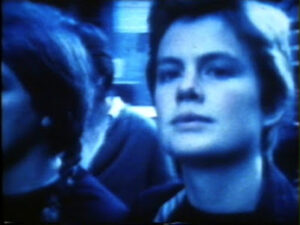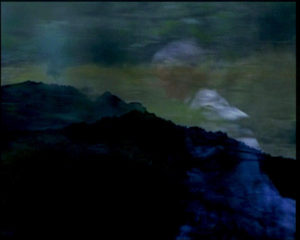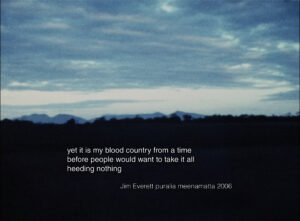Intertextuality – Memory Film is composed of silent Super 8 images only, so this family photo (I call ‘The Film Fathers and the Pregnant Wife’) is not in the film, yet it is in the film’s subconscious.
That’s my mum, Winifred, pregnant with me, 1948. Dad, Brian (L) and his dad JL. They are the cinema men exhibiting the American majors (MGM, Paramount, Twentieth Century Fox) and Cinesound & Movietone newsreels across Australian cities and country towns; before that JL exhibited the silents and was Manager of the Capitol, Melbourne from 1924-1938. Mum is so vulnerable, her arms protectively crossed across her body, under the gaze of her father in law. These film fathers are part of me, as is our dear Mum, who struggled to find herself and a road to freedom. Memory Film is the story of an inner mind and outer culture (the personal and the political) ebbing and flowing towards freedom – falling apart, falling apart, always falling apart, yet pearls are emerging from the mud.
PERSONAL ARCHIVE – NATIONAL ARCHIVE
‘Maestros of the Archive’ (video), OzDox Forum, AFTRS 2014
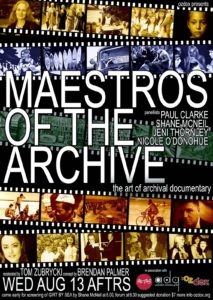
“The archive of the self and deconstructing the national archive,” OzDox Forum, 2014 Jeni Thornley, Panelist.
“…what image do you choose to represent or communicate an idea, or a feeling; how do you work with your own subjective memory…and how might your own personal archive link to public history – the historical record of a nation; and where does your intention and ethics play out in all of this? Also I want to note the difference between approaching the archive as a source of shots for a film, in contrast to thinking about the archive as metaphor: that is, reading the grain of the archive, AND reading against the grain of the archive – to hear the whispers in the archive, to see the problem of the archive and what’s not there; and to think about the nature of power in the production of the archive itself.”
FEMINIST ARCHIVE
‘In Australian independent cinema over the last three decades, Jeni Thornley is the filmmaker whose autobiographical project has been to articulate feminism as a historical crisis of female subjectivity.’ Felicity Collins.
As a founding member of the Sydney Women’s Film Group and Feminist Film Workers, and as the daughter of a film exhibitor, Thornley’s exploration of this crisis has been intimately bound up with cinema and the problems that the cinematic apparatus poses for women as spectators and as filmmakers. As an actor, filmmaker, distributor and critic (as well as a founding member of the Balmain Women’s Liberation Group in 1969) Thornley has alternated between social action documentaries and personal filmmaking. Between 1970 and 1996 Thornley has been involved in the production of four key films which can be read not only in autobiographical terms but also as a body of work which constructs second wave feminism as a ‘crisis’ of female subjectivity.
A film for discussion, (1973, Martha Ansara & SWFG) ends with this extended shot of the main character contemplating her mirror reflection – in a state of existential crisis.
In Maidens (1978) feminism itself is perceived as a crisis which ruptures the continuity of matrilineal history.
For love or money (1983 McMurchy, Nash, Oliver, Thornley) draws on the national film archive to produce a feminist history of Australian women at work, drawing conflicting experiences of race, class and ethnicity into an apocalyptic ending.
To the other shore (1996) is an autobiographical, compilation film which draws on archival footage, documentaries, feature films, independent feminist films, home movies and family photographs to construct a public, autobiographical memory of the female self as both mother and daughter, as Kleinian analysand and as autobiographical filmmaker”.

Anne Tenney as ‘The Woman’ in To the Other Shore
Felicity Collins, Memory in Ruins: The Woman Filmmaker in Her Father’s Cinema, Screening the Past. No. 13, 2001. Felicity Collins, The experimental practice of history in the filmwork of Jeni Thornley, Screening the Past, 1998.
Island Home Country (2008)
“The colonial layer feels like skin. What if I shed it and see with different eyes?”
In this film the ethical question on the use of the archive and working with the Tasmanian Aboriginal community and their protocols becomes the very foundation of that film’s process. This film is about my memories, growing up in Tasmania, and knowing no Aboriginal history or culture. Here is an island where the violent race war, (some call it attempted genocide, others ethnic cleansing) has been so repressed that approaching this terrain is a mine-field – whichever way you turn; the existing archive of documents, photos and film has been produced by the victors of that war.
The present day Tasmanian Aboriginal community do not welcome ‘outsiders’ using that material about them. How to proceed? The film takes 5 years of negotiation, of edits and re-filming. The Aboriginal community are crystal clear: don’t make a film about us, make a film about you, your mob. It’s here I became “the other” and experienced “instability” around being white.
For this internal feeling I created that visual metaphor (above) –“the white ghost of Australian history”, based on a character I played in Woo Joung Kim’s film Mad Woman’s Mountain 2003. A significant sequence in Memory Film (2023) revisits & re-contextualises the Super 8 I filmed in Tasmania during the 198os and 1990s, and also used in Island Home Country in 2008.
Fifteen years down the track – another Intertextual intervention with the same Super 8 in Memory Film. But different ! Thanks to sound designer Tristan Meredith and subtle, intuitive work on this traumatic episode of the 1830 British military and civilian war waged against Aboriginal Tasmanians and their resistance.

